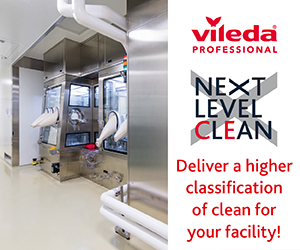The market landscape for aseptic pharmaceutical processing is changing incredibly quickly. The COVID-19 pandemic, combined with the recent blockage of the Suez Canal, has caused considerable disruption to delicate global supply networks.
These have disrupted essential supplies for sterile manufacturing — from raw ingredients for products to materials for primary and secondary packaging.
To mitigate against such issues, many pharma companies are reconsidering their supplier relationships and exploring how they can minimise risk. The diversification of supply chains, the on-shoring of some relationships and the replacement of some suppliers with more robust and reliable alternatives are all being investigated by the industry to guard against delays in the future.
In response, many manufacturers are looking to expand their operational capabilities and building aseptic lines in new markets.
This is key to enabling drug developers to diversify their supply chains, making them less reliant on any single country or geographic region to mitigate against future disruption. With all of this in mind, it is no surprise that the aseptic processing market is projected to grow to more than $73.6 billion by 2027, up from $62.2 billion in 2020.1
Incoming regulatory hurdles to expanding sterile capacity
However, keeping up with customer demand for aseptic processing is not simply a question of expanding existing sterile capacity and maintaining the operational status quo. New regulations are on the horizon that are set to change the way sterile manufacturing operates.
In particular, the Good Manufacturing Practices (GMP) Annex 1 (sterile products) is about to be revised, following a new consultation draft published in 2020.2,3
Hailed as an extensive rewrite of the 2008 edition, the updated Annex 1 will have a number of implications for aseptic processing and containment, particularly in relation to Contamination Control Strategy (CCS) in cleanroom zones.

Ben Wylie
A new section regarding closed systems provides a number of elements that pharma manufacturers will need to consider to ensure that their CCS complies with the new Annex 1.
They must demonstrate that their system has not only been designed to ensure integrity, but also to minimise the number of manual interventions to maintain sterility. Comprehensive risk assessment and new methods of monitoring integrity will be needed to comply.
Technology changing to keep up
To help manufacturers expand their aseptic capacity and upgrade it to ensure compliance with ever more stringent regulations, containment technology is adapting quickly.
One way that containment equipment is evolving to support drug developers, and ensure compliance with the new Annex 1 requirement to optimise integrity and minimise manual intervention, is the rise of hybrid single use (SU) technology.
There are a number of key advantages to SU equipment in sterile pharmaceutical production. They are generally easy to use, with minimal training or production line upgrades required.
As they are designed to be used once prior to disposal, they can significantly streamline the cleaning and validation procedures needed to maintain sterility, optimising integrity while reducing production downtime.
In addition, they ensure the aseptic integrity of products during transit as well as within manufacturing facilities. All of this allows firms to maintain optimum product quality while helping to maximise process efficiency and reduce production costs.
SU technologies making an impact
One key example of a single use technology that has the potential to help drug developers comply with increasingly stringent containment legislation is the split butterfly valve (SBV).
These offer a solution for the sterile transfer of powders, including drug substance and drug product, into and out of process equipment during the pharmaceutical manufacturing process.
SBV technology is made up of two components: an active half connected to the production line equipment and a passive half attached to a filling container.
When these two halves are fitted together, a single plate is created that allows product to flow from the line into the container via the interior surface of each half — without it coming into contact with the surrounding environment and maintaining aseptic integrity.
A new disposable version of the passive component of the SBV now exists, which can help to achieve the same stringent level of aseptic processing while significantly enhancing efficiency.

This disposable passive half can be connected to a single use flexible bag to enable the contained and sterile transfer of pharmaceutical powders between each step in the manufacturing process, as well as between facilities. The passive half doesn’t need to be cleaned after use as it can simply be disposed of between fillings, thereby increasing productivity.
These disposable SBV variants are manufactured within an ISO 6 cleanroom environment and are sterilised prior to use. This sterilisation is traditionally done by gamma radiation and qualified according to ISO 11137.
X-rays are increasingly being used, which reduces the degradation that could happen during the irradiation process with some materials. Regardless of the sterilisation process used, this step means that such components are suitable for use in aseptic processing environments, helping to maintain sterile integrity in compliance with current and incoming regulations.
The future of cleanroom technology
SU equipment is not the only cleanroom innovation that can support pharma manufacturers in ensuring ongoing regulatory compliance. The development of “smart factory” technology also has exciting potential to optimise aseptic integrity.
The “smart factory” concept entails the integration of smart monitoring technology into pharmaceutical production lines to provide rich real-time data on the status of equipment installed on the line.
Having this real-time equipment usage data can help drug developers to generate an audit trail much more quickly. This can allow health and safety teams, and individuals responsible for regulatory compliance, to proactively manage the validation programmes for their aseptic lines.
Data can be accessed from a mobile device or using an online dashboard, allowing for remote data access, so health and safety teams can monitor the usage of valve components while they are on the move. They can even monitor SBVs that they don’t have immediate access to, such as those in different facilities.
Smart monitoring technology can also revolutionise the containment strategies traditionally used in drug manufacturing by providing manufacturers with a reliable and fully automated means of understanding the health status of the valves on their lines.
This real-time information can help line operatives to identify when maintenance is needed well before aseptic integrity or productivity is affected, helping them to plan preventive action in a way that minimises downtime. In doing so, it ensures that SBV maintenance can be performed proactively, helping to manage risk and safeguard compliance with new Annex 1 integrity requirements.
Harnessing innovation to face the future of aseptic processing
The issue of how to meet growing demand for sterile manufacturing while complying with increasingly stringent regulations is growing ever more pressing. Drug developers need to take steps now to future-proof their aseptic processes to keep up.
However, through the use of advanced cleanroom technology — from SU equipment to smart monitoring tools — drug developers and contract manufacturers can be confident that they are ready to face this new world. Armed with the unique convenience, productivity and control benefits of SU technology, they can continue to be compliant with regulations, remain competitive and look forward to a successful future.
References
- www.globenewswire.com/news-release/2020/10/27/2114839/0/en/Global-Aseptic-Processing-Industry.html.
- https://ec.europa.eu/health/sites/default/files/files/gmp/2017_12_pc_annex1_consultation_document.pdf.
- www.honeymangroup.com/training/articles/annex-1-revision-2020.




